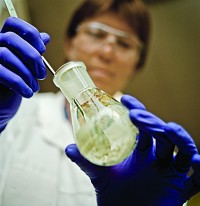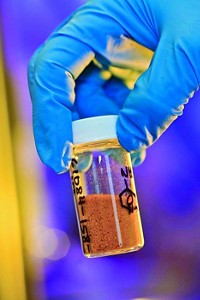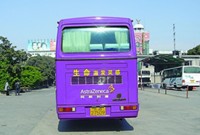Advertisement
Grab your lab coat. Let's get started
Welcome!
Welcome!
Create an account below to get 6 C&EN articles per month, receive newsletters and more - all free.
It seems this is your first time logging in online. Please enter the following information to continue.
As an ACS member you automatically get access to this site. All we need is few more details to create your reading experience.
Not you? Sign in with a different account.
Not you? Sign in with a different account.
ERROR 1
ERROR 1
ERROR 2
ERROR 2
ERROR 2
ERROR 2
ERROR 2
Password and Confirm password must match.
If you have an ACS member number, please enter it here so we can link this account to your membership. (optional)
ERROR 2
ACS values your privacy. By submitting your information, you are gaining access to C&EN and subscribing to our weekly newsletter. We use the information you provide to make your reading experience better, and we will never sell your data to third party members.
Business
Pipeline Payoff Helps Pharma
Drug company first-half results were helped by new product launches and emerging-market sales
by Ann M. Thayer
August 15, 2011
| A version of this story appeared in
Volume 89, Issue 33

If the first quarter of 2011 was all about promises of things to come, the second quarter saw some actual results. Many of the major pharmaceutical companies focused their recent earnings reports on new products and new markets for them. At the same time, they continued to make cuts in light of generics competition.
Novartis was among those bearing the most fruit. The Swiss company reported four new product approvals in the quarter, giving it a total of seven for the first half of the year. Sales of recently launched products grew 34% when compared with the same quarter last year and accounted for 28% of the company’s pharmaceutical sales. Overall sales for the quarter were $14.9 billion, a 27% gain over 2010.
For the full year, Novartis expects its pharmaceuticals business to grow at a low- to mid-single-digit rate, with growth in sales volumes more than offsetting the impact of generics competition. The firm’s success with new products was evident in the second quarter, when they helped offset the loss of patent protection on its cancer drug Femara and blood pressure medicine Diovan.
Meanwhile, revenues in Novartis’ vaccines and diagnostics business declined 47% because it didn’t have the boost from H1N1 influenza-related products that it did in 2010, when there were still lingering fears of a pandemic. Roche, GlaxoSmithKline, and Sanofi also tried to downplay the impact of lost H1N1 sales by emphasizing results with these products subtracted out. With them included, all three companies saw their sales decline in the first half.
GSK counts its influenza products, as well as the loss of patent protection on its antiviral Valtrex and restrictions on sales of its diabetes drug Avandia, among the now-abating headwinds that it faces, according to Chief Executive Officer Andrew Witty. Excluding them, GSK’s underlying pharmaceuticals business expanded about 4.5% in each of the past six quarters. “It’s pretty clear that we’re now in a position where we’re able to deliver sustainable underlying sales growth,” he said.
Witty has been working for years to steer the company around a patent vortex and away from mature Western markets. About 37% of GSK’s sales in the quarter were outside North America and Europe. These results, he told stock analysts in a recent conference call, “start to show the shape of what the future of GlaxoSmithKline is going to be.”
As its restructuring program comes to an end, Witty pointed out, 25,000 people have left the company and 17,000 have been added. Most of the people leaving were based in the traditional pharma business in the West, while most who have joined are in the East in emerging markets. “This is very much a global group, very much exposed to the opportunities that we see now in the emerging markets of the world,” he added.
This opportunity isn’t lost on other companies. Emerging markets—including the BRIC group of Brazil, Russia, India, and China—accounted for 10 to 30% of sales at most of the major drug companies. These markets also are offering disproportionately high rates of growth, as reported by the companies for the second quarter.
“Sales declined in the U.S. and Western Europe, where we bear the brunt of the generic penetration and the government price interventions, in contrast to sales growth in the established rest of world and in emerging markets,” AstraZeneca CEO David Brennan told analysts in his call. So far this year, his company has had seven product approvals in major geographies and the BRIC markets. The net effect was flat sales and earnings for the first half.
Pfizer’s sales and earnings also have been flat, but its emerging market experience is somewhat different. Although these markets expand rapidly as companies create new business there, they eventually have the same downside as any other market. For example, the loss of patent protection for Lipitor in Brazil and Mexico and for Viagra in Brazil reduced Pfizer’s emerging-market sales by 3% in the second quarter. This decline, however, was offset by gains for other products; the result was an overall 7% increase in emerging-market sales.
Japan has emerged as another key non-Western market, showing strength over the past 18 months, according to GSK’s Witty. “We continue to see a very substantial rollout of new medicines and new vaccines,” he said about the opportunities in Japan. A new approach to pricing has also been an incentive for drug companies. “The government made some very good changes to the way that they reward innovative medicines and vaccines last year, and that’s helping the business,” Witty added.
Japan also was a bright spot in the second quarter for Merck & Co., which won three drug approvals from Japanese health authorities. Its new hepatitis drug Victrelis, meanwhile, was green-lighted in the U.S. and Europe. “Double-digit growth from key products and successful new product launches in markets worldwide led to Merck’s strong second-quarter results,” said CEO Kenneth C. Frazier. Earnings were up about 9% on a 7% increase in sales.
“With more than a dozen product launches under way in various markets, we believe this speaks well of our ability to deliver new drugs from our research pipeline,” Frazier said. Merck has been managing its R&D programs through a new decision-making process, he explained, and “is being more aggressive about prioritizing the programs as well as the therapeutic areas where we will invest.”
Stock analysts at Citigroup Global Markets, however, are concerned about “cracks in the innovation core” at Merck. “Merck’s long-term growth is predicated on innovation; however, the growing number of pipeline setbacks is uncharacteristic,” John T. Boris wrote to clients. When reporting earnings, Merck announced yet another setback with its decision to stop clinical development of its migraine drug telcagepant.
With the release of its earnings, Merck also announced a workforce reduction of 13% by 2015 as part of its ongoing effort to reduce costs (C&EN, Aug. 8, page 10). Most of the job cuts will come in administrative and headquarters operations, and through the sale or closure of manufacturing sites. At the same time, Merck says it will continue to hire “in key areas like emerging markets where we have significant growth opportunities before us.”
Other companies have been similarly trimming discovery and manufacturing operations. GSK has changed its production footprint in the past three years, selling or closing 46 plants and adding another 12 through acquisitions to end up with 77. The company’s R&D headcount also is down 27%, and it is operating with fewer facilities. Witty pointed out that GSK is doing significantly less in discovery—half its discovery work is conducted by academics—and spending more internally on development.
Roche, on the other hand, said it is looking to keep R&D expenses level despite its expanding late-stage development pipeline. Its pipeline has grown to 12 new molecular entities, from just two in 2007, despite setbacks in 2010. Since late 2010, the company has had an operational excellence program that has cut jobs and reorganized some R&D and manufacturing.

Near term, Pfizer also is banking on late-stage developments and recent new drug filings in the U.S., Europe, and Japan. During the quarter it established external partnerships with eight academic medical centers in the Boston area, as it had earlier in New York and California. “Notably, we prioritized the pre-proof-of-concept portfolio, terminating over 90 programs that we felt were outside our priority disease area or not scientifically or commercially attractive,” CEO Ian C. Read said.
Two years ago, Sanofi reduced its R&D portfolio by 35 to 40% to focus on its most promising candidates. “Almost everything that we decided to keep has now progressed,” CEO Chris Viehbacher reported when announcing earnings. As a result, Viehbacher said he has more confidence about the firm’s drug pipeline decision-making process.
Sanofi’s growth strategy includes a focus on new products, emerging markets, and its recent acquisition of Genzyme. In the second quarter, the company’s growth platforms grew a combined 9.5% and accounted for 65% of sales. Overall sales for the quarter were flat, and net earnings fell 13%.
“We made a massive effort two years ago to reallocate resources and shift management attention, and strategically align the whole company behind these growth platforms,” Viehbacher said. “The growth platforms are not just there to replace lost sales, but to restructure the sales into areas of business that have natural barriers to entry and which are substantially less exposed to patent expiries.”
Sanofi has been working to integrate the Genzyme business. The biotech firm had been addressing a consent decree from regulators, fixing manufacturing problems, and trying to return to normal production. At $1.15 billion, Genzyme product sales in the second quarter came in ahead of analyst expectations, although the company recently warned of another supply setback.
As big pharma companies buy biotech firms such as Genzyme to expand their portfolios and feed their pipelines, the number of large firms in the biotech sector has shrunk. This quarter C&EN has added two companies to its ranking—the Swiss firm Actelion and Ireland’s Elan—to help round out the earnings picture.
Overall biotech company results were good in the quarter, with both sales and earnings up more than 9% for the firms’ C&EN surveys. For the half year, sales rose and earnings declined, although most companies remained profitable. A clear standout was Celgene, which reported sizable gains from continued growth in product sales.
As the top biotech companies mature, many are facing the same issues as their pharmaceutical industry counterparts. New products are helping to increase sales at Amgen and Biogen Idec, but a few drugs are now old enough to face generics competition. But Amgen’s products, for example, are managing to hold their own against generic biologics, or biosimilars, in Europe, and the company expects they will also do so when biosimilars are approved in the U.S.
“Certainly, we’ll have a robust biosimilar environment in the U.S., but it’s hard to predict exactly when, hard to predict how many,” Amgen CEO Kevin Sharer told analysts. He reminded them that biosimilars will be nothing like generic small-molecule drugs because they will require investments in clinical trials, manufacturing, regulatory approval, and marketing.
Competition is coming from big pharma, which has made a push into bio-similiars. Merck, for example, has predicted that it will have five late-stage biosimilar products—including versions of Amgen’s Enbrel, Neupogen, and Neulasta—by the end of 2012. In the end, Sharer believes the biosimilar market will be not unlike any business with multiple competitors.





Join the conversation
Contact the reporter
Submit a Letter to the Editor for publication
Engage with us on Twitter